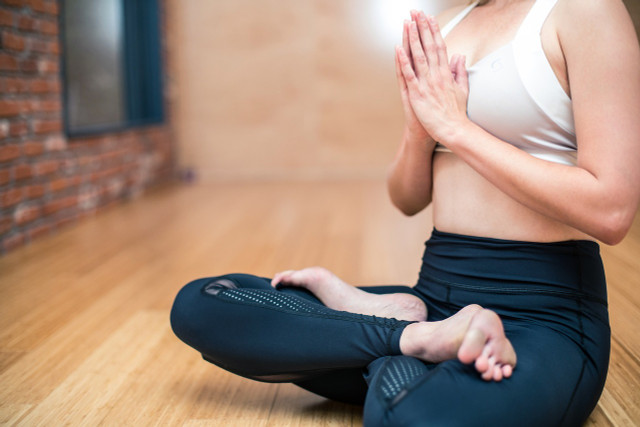
Especially for beginners, learning to meditate is often difficult without proper guidance. Our tips show you how you can approach the first steps of meditation.
The essentials in brief:
- Meditation is an ancient spiritual practice. It includes contemplative (passive) and active forms.
- Simple breathing exercises are ideal for beginners.
- Learn to accept uncontrolled thoughts during meditation and integrate meditation regularly into your daily routine.
- In addition to breathing, you can concentrate on physical sensations, feelings or sounds. Meditation apps and courses are additional tools.
Learning Meditation: The Basic Principles
Meditation is a spiritual practice that people have been practicing for thousands of years. The search for its roots often leads us to the Far East, but forms of meditation were also practiced in Christianity centuries ago.
There are various forms of meditation that differ in their external appearance and inner mental attitude. In terms of the external form, a distinction is made between two types of meditation:
-
Contemplative meditation: Here the meditator sits, sometimes lies down or stands. In any case, he or she does not move, which is why it is also referred to as passive meditation. This includes, for example, Vipassana, Zazen and Samatha meditation. Modern mindfulness exercises are also derived from these forms of meditation.
-
Active meditation: These types of meditation involve physical exercises, using the voice or integrating mindfulness into actions. These include forms of yoga, tantra or certain martial arts styles. Conscious walking or reciting prayers and mantras are also part of active meditation.
As different as the forms of meditation may be, the essential core of all of them is concentration or focusing of attention. The meditator can concentrate on different objects, such as breathing, thoughts, physical sensations and emotions, but also on an image in the mind’s eye, sounds or smells.
We asked the experts from the meditation app 7mind what simple tip you can use to start meditating: “Try a simple breathing exercise: To arrive in the present moment, you can direct your attention fully to a physical sensation. In mindfulness meditation, breathing is often the focus because it happens all by itself. This has the great advantage that you don’t have to do anything other than concentrate on the feeling of the air flowing in and out.” The deeper breathing triggers a relaxation response in the body. The slowed breathing lowers blood pressure, calms the nervous system and releases inner tension.
Studies show that meditation reduces stress, improves your health, makes you more relaxed and improves your concentration. “Meditation can have a positive effect on our physical and mental health and our sleep,” say the experts at 7mind.
Learn to meditate – Step 1: Your place of silence

(Photo: CC0 / Pixabay / susuteh)
With our step-by-step instructions, you will learn a classic passive meditation on the breath, which is more suitable for beginners than the active types of meditation.
- Find a place where you want to meditate. It should be clean and something you like. There should be as few external influences as possible that could disturb your meditation. This includes unnecessary objects and noises.
- Of course, you can meditate anywhere, even your garden or a place in nature. For regular practice, however, it is good if you have a fixed place in your home. Also read: Setting up a meditation corner at home: Your place for mindfulness.
- External silence is very useful for finding inner peace, so make sure in advance that you will not be interrupted by your phone or anyone else for the duration of the meditation.
Step 2: Sitting upright

(Photo: CC0 / Pixabay / lograstudio)
You don’t have to sit in the lotus position (“Buddha pose”) to meditate. You can choose any sitting position. Two factors are particularly important:
- Firstly, your spine should be aligned and your back should be straight.
- Secondly, the position should be comfortable enough that you can hold it still for at least ten minutes.
The lotus, the tailor seat and the heel seat are three suitable sitting positions. If you cannot sit upright like this, sit on a cushion or a rolled-up blanket. For the long term, a special meditation cushion is recommended (e.g. from Avocadostore). If the floor beneath you is cold, you can put a blanket, a towel or a mat underneath. It is not a problem if your feet fall asleep while meditating.
If you have pain when sitting on the floor for health reasons, you can also sit on a chair. But do not lean back and make sure that your back is straight.
Basically, your body should be as relaxed as possible: let your shoulders drop down, place your hands loosely on your knees or lap and relax all the muscles that you don’t need for an upright posture, for example the facial muscles.
Step 3: The actual meditation

(Photo: CC0 / Pixabay / leninscape)
Alarm clock: Before you start meditating, set a timer that signals the end of the meditation with a gentle alarm tone. To start with, it is enough to sit for ten minutes. Over time, you can increase the duration.
-
Close your eyes.
- Take five conscious breaths. Use these to relax your mind and body and to arrive within yourself.
- Now keep your attention on your breath while you let it flow naturally. Notice how it flows in and out, following the path of the air from your nose to your lungs. Pay attention to the smallest details, such as where the air touches your nasal passages and throat and how your chest and chest expand as you breathe in. If you lose focus and are distracted by thoughts, gently bring your attention back to your breath. The goal is to concentrate on your breath the entire time.
Step 4: Waking up
Don’t jump up immediately when your alarm goes off. Instead, try to carry the meditative mindset into your next actions. Stay aware of your breathing as you gently open your eyes and slowly stand up.
Caution: If your legs or feet have fallen asleep, you should first loosen your seat and wait. Do not stand up until you can feel your limbs normally again.
Tips for your meditation

(Photo: CC0 / Pixabay / lograstudio)
Disturbing thoughts
- In the beginning, your attention will certainly be interrupted by uncontrolled thoughts. Don’t worry, this is completely normal and happens to everyone who wants to learn to meditate.
- 7mind makes it clear: “Contrary to many prejudices, thoughts and feelings should not be suppressed or switched off during meditation. Many beginners become frustrated when they cannot quite clear their heads at first. It may sound surprising, but the goal of mindful awareness of your mind is not to stop thinking about anything. In fact, your mind will continue to be active during meditation. You may even find yourself thinking more the more you try to observe your thoughts.”
- The experts also recommend simply letting your thoughts wander. The point is not to judge your thoughts. It is important not to chase your own thoughts or hold on to them for too long.
Duration and frequency
- The length of your meditation sessions is not so important at the beginning. Ten minutes is perfectly sufficient to start with. What is more important, however, is that you practice regularly. Integrate meditation into your daily routine: The best way to do this is to simply get up ten minutes earlier in the morning and start the day by meditating. A second session in the evening is also recommended.
- After a few days or weeks, you can then extend the duration in five-minute increments.
Object of focus
The type of meditation presented is a good way to start. As you have already learned, you can also make other objects part of your meditation.
For example, you can concentrate on…
- …your physical sensations (pain, warmth, pressure, tingling, etc.),
- …your feelings (joy, sadness, fear, discomfort, loneliness, etc.),
- …certain sounds (e.g. the sound of your breath, music or a singing bowl),
- …certain things (focus your gaze on candle flames or another object).
With mindfulness you can also integrate meditation into your everyday life.
Other ways to learn to meditate
- There are now wonderful meditation apps for smartphones that offer guided meditation. These are particularly suitable for beginners.
- In addition, there are meditation centers and associations in many larger cities that regularly offer group meditations for beginners. More and more meditation courses are also being offered at universities and schools.
- If you want to delve deeper into the practice of meditation, we recommend the donation-based ten-day courses offered by the Vipassana Association.
Read also: I meditated daily for 100 days – this is how it changed me
Read more on Utopia:
- Digital Detox: consciously go offline
- Yoga for beginners – these tips will make it easier for you to get started
- Ashtanga Yoga: Information for beginners and interested people
Revised by Benjamin Knöll
** marked with ** or orange underlined Links to sources are partly affiliate links: If you buy here, you are actively supporting Techzle\.com, because we then receive a small part of the sales proceeds. .